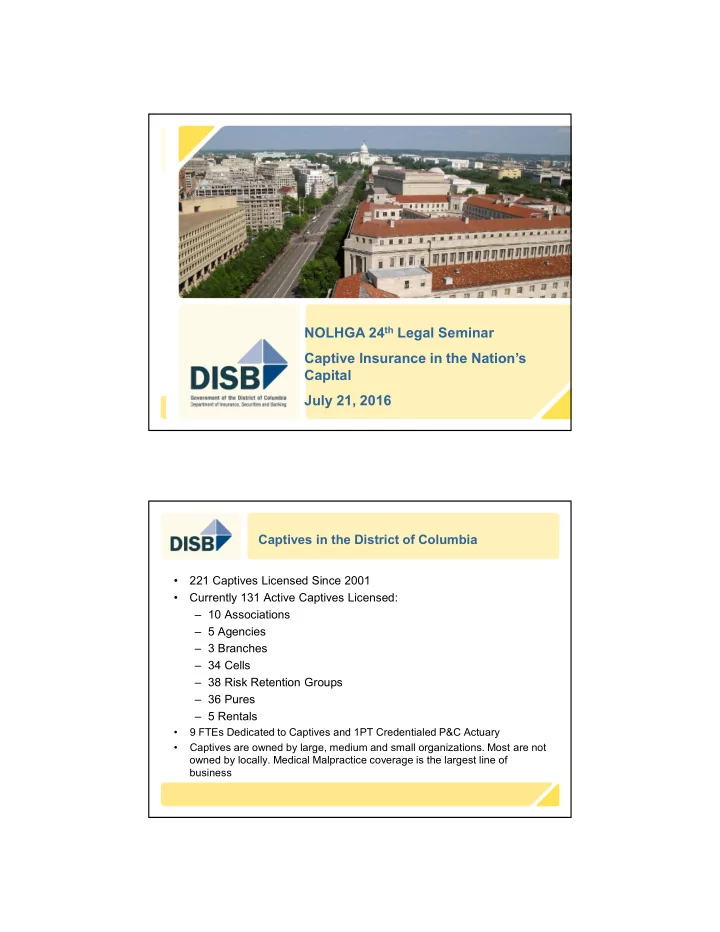

NOLHGA 24 th Legal Seminar Captive Insurance in the Nation’s Capital July 21, 2016 1 Captives in the District of Columbia • 221 Captives Licensed Since 2001 • Currently 131 Active Captives Licensed: – 10 Associations – 5 Agencies – 3 Branches – 34 Cells – 38 Risk Retention Groups – 36 Pures – 5 Rentals • 9 FTEs Dedicated to Captives and 1PT Credentialed P&C Actuary • Captives are owned by large, medium and small organizations. Most are not owned by locally. Medical Malpractice coverage is the largest line of business 2
Types of Captive Insurers Single-Parent Captive: • – Wholly owned by one parent company – Insures or reinsures the risks of its parent, affiliated entities, or chosen unrelated parties • Branch Captive: – A division of a single parent captive that is usually formed in the U.S. (as a branch (Office) of an Alien Insurer) – Allows a company access to TRIA and U.S. employee benefit coverages that are required to be in a U.S. domicile • Group/Association: – Owned by multiple companies or an association, and insures or reinsures the risks of the group 3 Types of Captive Insurers (Continued) • Risk Retention Group: – Regulated under federal legislation, licensed in one state, and able to operate in all 50 states on a registered basis – Can only write liability lines of risk (not WC) • Pending legislation may permit RRGs to directly insure property coverage • Protected Cell Captives (PCC) or Cell Captives: – Insures or reinsures the risks of unrelated parties, whereby insureds are “renting” capacity – DC Incorporated and Unincorporated Cells – The PCC Required to Have Minimum Capital (e.g., $1,000) 4
Types of Coverage Permitted in Captives • Captives can insure a variety of risks: life, health, annuities, indemnity, property and casualty, fidelity, guaranty and title • Generally may not write private passenger automobile or homeowners insurance but they may cede and accept reinsurance for those risks • Generally may provide excess worker’s compensation insurance and may reinsure worker’s compensation of a qualified self-insured plan of its parent and affiliated companies and, further, may insure deductibles/SIRs for worker’s compensation • A few states allow captives to write direct worker’s compensation insurance 5 Regulation of Captives • Captives are Regulated • Not subject to “Traditional” Regulation • Regulated by “Business Plan” • Capital Requirements • Regular Financial Analysis and Periodic Examination • Annual Audit and Actuarial Report • Subject to Rehabilitation and Liquidation Laws 6
Guaranty Association Benefits Company ("GABC") On April 16, 2012, the Supreme Court of the State of New York, Nassau County, entered an order finding ELNY to be insolvent and approved a Restructuring Agreement in connection with the liquidation and restructuring of ELNY (available at www.gabenefitsco.com). Certain of ELNY's assets and liabilities were transferred to Guaranty Association Benefits Company ("GABC"), a not-for-profit captive insurance company domiciled in the District of Columbia. The Participating GAs are the members of GABC. GABC was funded with ELNY’s assets, GA assessments, and contributions from the life insurance industry. GABC has assumed the GA covered and life industry guaranteed ELNY liabilities and will make payments to ELNY beneficiaries as they become due and payable in accordance with the Restructuring Agreement. 7 GABC (Continued) • GABC regulated by DC like any other captive insurer. • Annual Financial Statements • Annual Actuarial Opinion on Reserves • Annual Audit • Subject to DC Financial Solvency Laws and Regulations • Subject to Periodic Financial Examinations • The NY Liquidation Bureau has on-going oversight of the ELNY Estate, but it does not regulate GABC. • The NYLB has rights to financial information, and may examine the affairs of GABC. • The NYLB may seek an order from the Receivership Court in the event of a Material Breach of the Restructuring Agreement. 8
GABC (Continued) • Run-Off Reinsured Liabilities – All Administration – Contract with Service Providers • Manage Assets – Investment Committee/Guidelines – Investment Managers • Single Point of Contact 9 Captive Run-Offs • DC has seen an increased interest in using Captives for run-offs • Most interest comes from long-tail business such as worker’s comp • Primary concern is insolvency due to insufficient assets to satisfy adverse development • Secondary concern is having to involve the court if the captive becomes insolvent • Companies want to buy books of business or entire companies to run-off, but do not want to provide financial guarantees 10
Captive Run-Offs (Continued) Rhode Island – Insurance Regulation 68 provides for Insurance Business Transfers IBT Plan Is Approved by the RI DOI Transferring Company Must Obtain Approval from Domestic Regulator Court Sanctioned Novation Brings Finality to the Transferring Company Transparent Process Policies Must Have Expired More Than 60 Months Before Filing of IBT No Material Adverse Effect on Policyholders The Assuming Insurer is Subject to Regulation by the RI DOI 11 Captive Run-Offs (Continued) Vermont Legacy Insurance Management Act (LIMA) LIMA Process is Entirely Regulatory (No Court Approval) Transferring Company Must Obtain Approval from Domestic Regulator VT DOI Sanctioned Novation Brings Finality to the Transferring Company Transparent Process Transferred Liabilities Must be in Run-Off (No In-Force Business and No Premiums) No Material Adverse Effect on Policyholders Policyholder or Inward Reinsurer May Opt Out of the Plan 12
Questions Contact Information: Dana Sheppard: Dana.sheppard@dc.gov (202) 442 – 7820 13
Recommend
More recommend